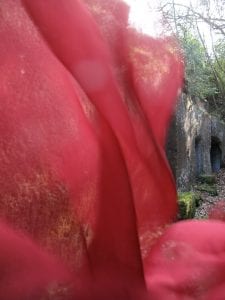Splicing Time. Rome and the Roman Campagna at UCL Art Museum
By Martine Rouleau, on 2 March 2017
Blog post written by Liz Rideal, Leverhume artist in residence at UCL Art Museum and Reader in Fine Art at the Slade School of Fine Art. She also lectures and writes educational material for the National Portrait Gallery.
Being invited to take up the role of artist in residence at UCL Art Museum was an unexpected outcome of Splicing Time, Rome and the Roman Campagna, my 2016-17 Leverhulme Fellowship.
One theme was to study Claude Lorraine’s Liber Veritatis drawings, in the British Museum’s collection and attempt to plot their contemporary locations, to study his concept of real, imagined and invented landscape and relate this imagery to my own work in the Roman Campagna today. However, it occurred to me that UCL Art Museum might also be a fruitful venue for my quest and I decided to approach curator Andrea Fredericksen to investigate this further. Coincidentally the museum’s upcoming Legacy exhibition was to concentrate on Richard Cooper Jnr, eighteenth century Grand Tour printmaker, an artist who followed the footsteps of Claude Lorraine and who was thus perfectly suited to my own theme. So, in this synchronous and surprising manner I started to consider Cooper Jnr’s work.
I’m coming to UCL Art Museum with the concept of the eighteenth century grand tourist and the desire of those visitors to Italy to take something home with them, a feeling that all of us can relate to when on our travels. Cooper Jnr was creating standard views for them (like many other artists of the time), as this was a reliable and profitable market. Today our snail-mail postcard equivalent is old-fashioned and instant messaging fills that gap, but then, travelling was for the very rich and their souvenir tastes were for painted postcard views often turned into prints.
My interest is in the repetition of form and the places that emerge in repeated views of the Roman Campagna; the standardisation of vistas and the imaginative embellishment of these. It was not unknown for artists who had not been to Italy, to draw, paint and make prints of invented landscapes based on other people’s work. Van de Velde is one such, and his work was recently on show at the Dulwich Picture Gallery, one might call his work a form of post-modern ‘vintage sampling’.
My artwork lies somewhere between the two, and I am creating prints based on old views and using new print technology to investigate the layering of visual information both old and new. I’ve printed and hand-coloured images of a quarry near Tivoli and also views by Claude Lorraine of Due Ponti off the via Flaminia. I’ve re-printed and re-painted them, creating accretions that in some ways replicate the layers of time passing, equivalent to those made visible in rock formation, and so echoing my initial Leverhulme brief of ‘splicing time’. These prints will form part of an album like Cooper Jnr’s thus updating the genre.
Water, perhaps as opposed of rock, is essential to life, flowing through the aqueducts that crisscross the Campagna landscape. Rock in comparison is immutable but used in building houses, roads and irrigation systems, facilitating drinking, washing and for Romans, important public bathing rituals. Rock provides the material for tombs both Etruscan, at Tarquinia and Cerveteri, and Roman such as Cecilia Metalla’s Appian Way monument and Cestius’s Pyramid in Rome itself.
My dual focus is on water and the abstract cutout caves peppering the Roman countryside, specifically stone quarries and their connected Etruscan hewn tombs. The latter describe simple repetitive sculptural forms made from malleable tufa much used as Roman building material. Yet, it is the spirit that I want to conjure and catch as it slides along the aqueducts and shifts shapes among the tombs and fountains. The essence of the people who inhabited the spaces long before the tourists roamed. To this end I’ve invented a way of suggesting their fragile presence through photographing trailing light-coloured fabrics. Thus Etruscan and Romans appear to inhabit my images in wraith-like bursts. Echoes of their ghosts are caught on camera like brief sparkles of morning dew, enticing us to suspend our disbelief and enter the realm of art.
Liz will produce new work to be displayed in UCL Art Museum as part of the Legacy exhibition from the 24th of April until the 9th of June 2017.
 Close
Close


